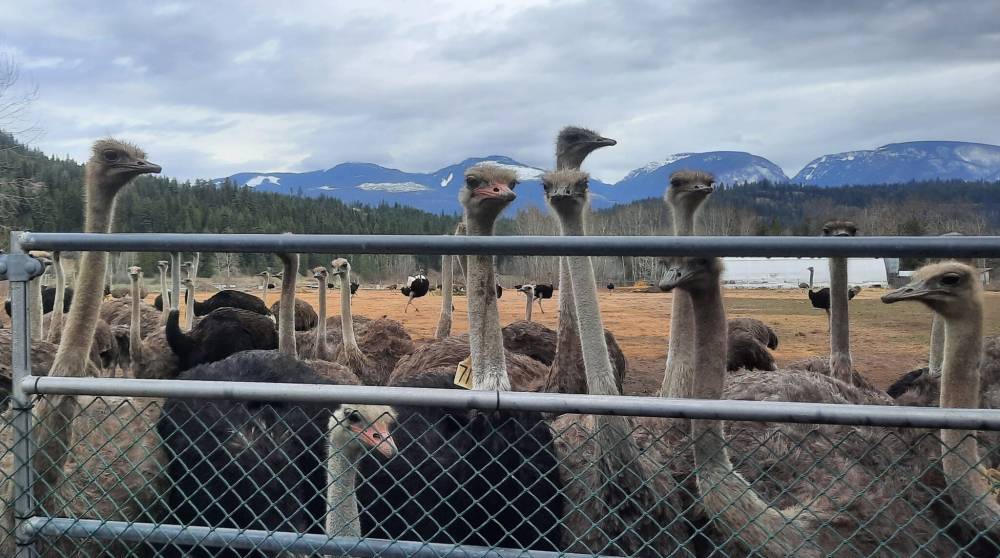Saga of B.C. ostrich farm nears necessary conclusion
Advertisement
Read this article for free:
or
Already have an account? Log in here »
To continue reading, please subscribe:
Monthly Digital Subscription
$1 per week for 24 weeks*
- Enjoy unlimited reading on winnipegfreepress.com
- Read the E-Edition, our digital replica newspaper
- Access News Break, our award-winning app
- Play interactive puzzles
*Billed as $4.00 plus GST every four weeks. After 24 weeks, price increases to the regular rate of $19.00 plus GST every four weeks. Offer available to new and qualified returning subscribers only. Cancel any time.
Monthly Digital Subscription
$4.75/week*
- Enjoy unlimited reading on winnipegfreepress.com
- Read the E-Edition, our digital replica newspaper
- Access News Break, our award-winning app
- Play interactive puzzles
*Billed as $19 plus GST every four weeks. Cancel any time.
To continue reading, please subscribe:
Add Winnipeg Free Press access to your Brandon Sun subscription for only
$1 for the first 4 weeks*
*$1 will be added to your next bill. After your 4 weeks access is complete your rate will increase by $0.00 a X percent off the regular rate.
Read unlimited articles for free today:
or
Already have an account? Log in here »
There’s a wide range of emotions circulating in the aftermath of a British Columbia court ruling this week that amounts to a death sentence for more than 400 ostriches.
In addition to grief and anger, there is also relief.
In a 137-page ruling, the Federal Court justice hearing the case made a heart-wrenching decision, while expressing sympathy for a family devastated by the pending destruction of these birds on the orders of the Canadian Food Inspection Agency.

KATIE PASITNEY PHOTO
A herd of ostriches is seen on a remote farm in Edgewood, B.C., in an undated photo supplied by Universal Ostrich Farms Inc.
Their owners, Universal Ostrich Farm near Edgewood, B.C., have vigorously campaigned to block December’s directive to cull the whole flock after tests confirmed 69 sick and dying birds were infected with highly pathogenic H5N1 avian influenza.
They’ve protested in the courts, launched a website to rally support and donations and appealed to politicians. Supporters were reportedly surrounding the farm as a human shield following the court decision. By midweek, the CFIA had blocked its X social media feed due to a flood of abusive comments.
However, attempts to portray this situation as an attack on farmers fall flat in the face of the potential repercussions for the rest of the country’s farmers and public health if these protests prevail.
Based on what we know today about the creeping invasion of avian influenza through wild and domestic bird populations, mammals and humans, euthanizing infected flocks is the best defence against the virus’s continued spread.
It also follows international guidelines, which lessens the risk of other countries closing their borders to Canadian products.
Since it first surfaced in 2021, avian influenza has hit 527 Canadian farms, ranging from commercial poultry operations to small backyard flocks. It has resulted in the illness-related deaths or euthanasia of more than 14.5 million birds. Two new cases were confirmed this month in western Manitoba poultry barns.
So far, there’s been only one confirmed human infection in Canada: a B.C. teenager who became critically ill last year but has since recovered. But the risk of human infection grows as the virus becomes more prevalent and continues to evolve.
And so far, it hasn’t surfaced in Canadian dairy cows or milk supply — unlike in the U.S., where it has affected dairy herds, workers and barn cats and shown up in unpasteurized milk sold in grocery stores. (The sale of raw milk is prohibited in Canada.)
While Canada’s “stamping-out policy” hasn’t eradicated the disease, which is virtually impossible to eliminate because of its prevalence in the wild bird population, it is credited with slowing its spread.
The judge quite rightly refused to weigh in on challenges to the scientific validity of the CFIA procedures, saying choosing between opposing scientific opinions is for policymakers, not the courts.
The judge also rejected claims the ostrich flock should be spared because it contains “rare and valuable poultry genetics” and some of the birds have developed immunity because they were exposed but didn’t die.
The court’s decision was based on whether CFIA’s actions are reasonable in the context of the agency’s mandate under federal legislation. It concluded they are.
“The stamping-out policy facilitates a faster return to disease-free status according to relevant international treaty, protects Canada’s export markets through negotiated trade agreements, and supports co-ordinated global efforts to reduce public health risks from this zoonotic disease,” the federal ruling says.
Federal authorities follow similar eradication protocols for numerous livestock diseases that threaten the national herd health, public health and which have implications for trade. Officials are currently dealing with an outbreak of bovine tuberculosis in a Saskatchewan beef cattle herd.
Exemptions are rare and the bar for considering them is high. Court documents cited a case where one turkey barn on a multi-barn site was exempted because it contained no disease and was well-enough separated from the others.
Even though owners are compensated financially for their losses, there’s profound mental anguish associated with culling a herd built over successive generations and with the extra work involved with inspections, testing and follow-up sanitation.
No one feels good about this week’s court decision. But making an exception would set a dangerous precedent.
Laura Rance is executive editor, production content lead for Glacier FarmMedia. She can be reached at lrance@farmmedia.com

Laura Rance is editorial director at Farm Business Communications.
Our newsroom depends on a growing audience of readers to power our journalism. If you are not a paid reader, please consider becoming a subscriber.
Our newsroom depends on its audience of readers to power our journalism. Thank you for your support.


